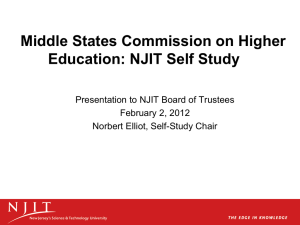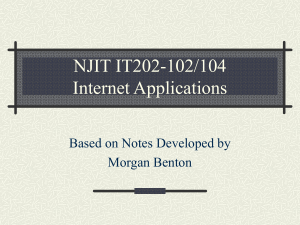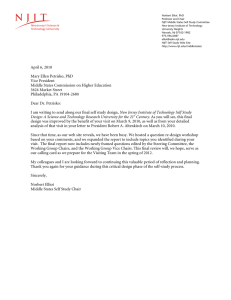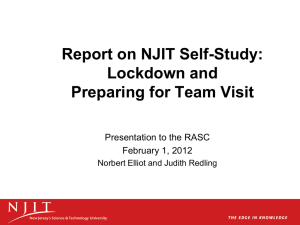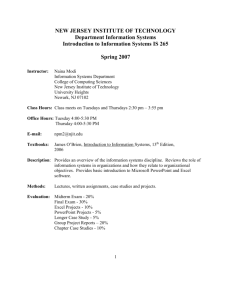Developing a Self Study Design: The NJIT Model Committee
advertisement
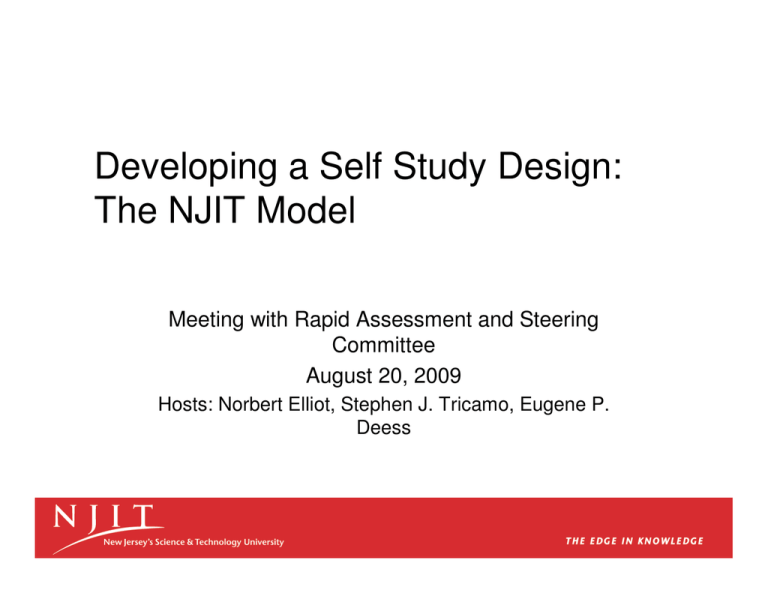
Developing a Self Study Design: The NJIT Model Meeting with Rapid Assessment and Steering Committee August 20, 2009 Hosts: Norbert Elliot, Stephen J. Tricamo, Eugene P. Deess The NJIT Self Study Design Model Prelude: What is a Self Study Design? • A blueprint for the self study model, the self study process, and the final self study report • A statement of the major outcomes that the institution expects for itself • A demonstration that the institution possesses the characteristics of excellence described in the Commission's 14 accreditation standards • A document length of under 50 pages Example 1: Statement of NJIT Major Expected Study Outcomes—A Reflective Orientation • To reflect on the paths that we have taken over the past decade – An examination of previous university strategic plans and their impact – An examination of all previous accreditation visits and their impact – An examination of all internal assessments and their impact Example 2: Statement of NJIT Major Expected Study Outcomes—A Documentary Orientation • To examine the impact of Project ORBIT (Organizational Reengineering using Banner Information Technology)—a multi-year, campus-wide effort to implement a new ERP (Enterprise Resource Planning) system—as a unifying technological force for the Commission's 14 accreditation standards – Transparency and accountability of administrative and academic processes – Vehicle for customer and student satisfaction Example 3: Statement of NJIT Major Expected Study Outcomes—A Progressive Orientation • To establish outcomes assessment efforts in student learning that will contribute towards student professionalism and curricular transformation – Design core competencies for each NJIT major and the General University Requirements – Support EPortfolios for each NJIT undergraduate so that core and GUR competencies may be expressed – Assess the core competencies as they are expressed within the EPortfolio – Employ the results of the assessment to strengthen the curriculum Application of the SMART System The Design: The NJIT Variables • Research-based – What questions will each of the 7 working groups pose and answer to address the Commission's 14 accreditation standards ? • Evidenced-based – What are the existing and needed documents and studies that must be produced for accreditation? • Objectives-based – Will the orientation of our major objectives be reflective, documentary, or progressive? • Document-based – What will the chapters of the study design and final report look like? • Shareholder-based – Who are the audiences for our work? • Milestone-based – What timelines will ensure a robust meeting, drafting, reviewing, and finalizing of the final report? • Future-oriented – What will be the impact of our design and report when the present accreditation cycle is completed? Outline for the Self Study Design 1. 2. 3. 4. 5. 6. 7. 8. 9. 10. 11. 12. Description of NJIT NJIT Mission Recent NJIT Developments MSCHE Accreditation and Resonance with the University Strategic Plan Future NJIT Expectations Justification of the NJIT Self Study Design Model Expectations from the NJIT Self Study Design Model Major Intended Outcomes from the Self Study Goals, Objectives, and Tactics for the Self Study Organization and Structure for the Self Study Shareholder Analysis Membership of the Rapid Assessment and Steering Committee 13. 14. 15. 16. 17. 18. 19. 20. 21. 22. 23. 24. Charge to the Rapid Assessment and Steering Committee Membership for the Seven Committees Core Charges to the Seven Committees Emerging Considerations from the Seven Committee s Outcomes Assessment Definition and Design Unifying the NJIT Self Study and MSCHE 14 standards Managing the Self-Study Process I: Time Line Managing the Self-Study Process I: Reporting Structures and Peer Review Managing the Self-Study Process III: Document Design Managing the Self-Study Process IV: Planning for Post-Accreditation Impact Profile Analysis for the Visiting Team Works Cited and Consulted

